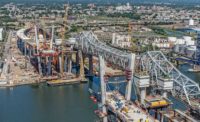
The world's fourth-longest steel arch bridge is receiving a lift—through both design and political will—without receiving an actual face-lift. An elaborate scheme for the 1,675-ft-long, 80-year-old Bayonne Bridge linking New Jersey and Staten Island would elevate the roadway to 215 ft above water, from 151 ft, without impacting the arch component or traffic.
Last month, owner Port Authority of New York & New Jersey announced that its designers, working with a joint venture of HDR Inc. and Parsons Brinckerhoff, had shortened the design period by six months. Then, under the We Can't Wait initiative, the Obama administration pledged that federal reviews of both the $1-billion Bayonne Bridge project and $1 billion in harbor dredging would be streamlined by several months, to spring 2014. Officials now expect to demolish the old roadway in 2015, not 2016.
A new four-lane roadway will be built above the existing one, within the arch. The new 215-ft clearance will allow modern large container ships to pass underneath after they arrive from the widened Panama Canal. "We chose to raise the roadway because it keeps the iconic arch, allows us to stay within the confines of the existing right-of-way and minimizes impacts overall," says Bernard Yostpille, the agency's chief structural engineer.
Design will wrap up by the end of the year, says Peter Zipf, the agency's chief engineer. One of five prequalified teams will be selected early next year. The teams are led by American Bridge, Tutor Perini and Traylor Brothers; Schiavone Construction, Granite Construction Northeast, Yonkers Contracting Co. and Defoe Corp.; Conti Enterprises, J.H. Reid, Judlau Contracting and DYWIDAG-Systems International USA; Flatiron Constructors, E.E. Cruz and Tully Construction; and Skanska Koch and Kiewit Infrastructure.
"Related to contractor feedback, we began looking at our design solutions and how to move construction along," says Zipf. "We wanted to optimize what we have rather than build a whole new bridge."
The outer, northbound lane and sidewalk will be removed first, making room for two lanes of traffic to shift west. Then, the east side will be demolished, making room for new precast concrete piers. A rolling gantry atop the piers will place precast road segments using a balanced cantilever method. Transfer load beams will allow removal of old suspender ropes. New ropes attached to the steel arch chords will support new floor beams, as will new stringers. Crews will attach temporary suspender ropes from the new floor beams to the old floor beams. Once traffic shifts to the new road, the process will be repeated for the other half.
The roadway will have wider lanes, new shoulders, and a biking and pedestrian path. Catherine Britell, port authority senior structural engineer, notes that while the width between the parallel arch trusses is 74 ft, "the roadway is only 40 ft wide. So, we had space to work with."
Designers used 3D modeling, as-built drawings, laser scans, and field and lab tests to identify major risks, notes Yostpille. Britell adds that unchanged bridge elements, such as truss abutments, are surveyed thoroughly.
For example, "the approach viaducts sit on concrete columns and are a significant portion of the bridge," says Zipf. "Do we re-use those columns? We did a series of assessments and determined that the best strategy is to replace those."
Designers also studied the anticipated stresses in the arch for every step of the process. "We are reframing and reinforcing some areas with tried-and-true techniques," says Zipf. "One of the biggest risks is when you get out there, you find unknowns. We've done extensive field surveys and even tested the structural steel."
While the existing road grade is 4.5%, the new road grade will be up to 5% in order for the higher-level road to tie into the existing ramp connections, says Britell. The agency's program director, Joann Papageorgis, reassured attendees at an April conference on the Panama Canal, saying, "Will [the increased grade] make the road feel like a ski slope? No."





Post a comment to this article
Report Abusive Comment